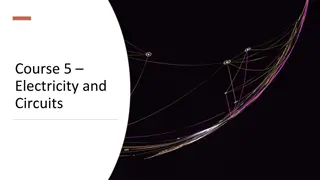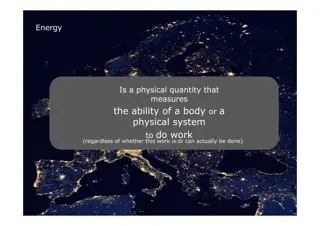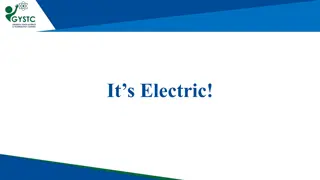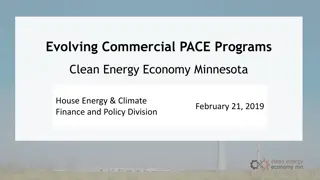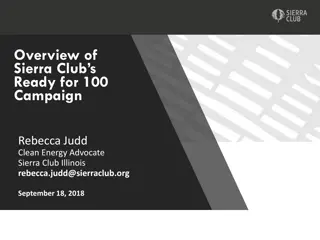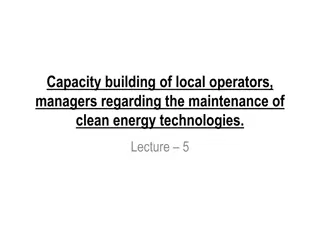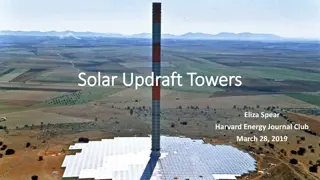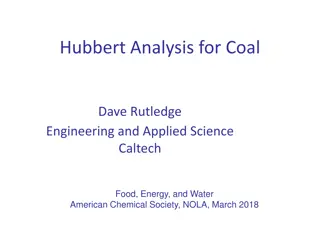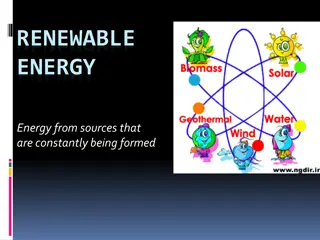Clean Energy Systems: Harnessing Natural Cycles for Sustainable Electricity Production
Clean energy systems tap into natural energy sources like wind, water, sunlight, and biomass to generate electricity sustainably, reducing pollution and global warming emissions. Transitioning to renewable energy technologies can combat climate change, improve air and water quality, create jobs, and lead to a cleaner, safer energy future. Additionally, advancements in catalyst technology offer potential for converting carbon dioxide into fuel, while cleaner biofuels like cellulosic biofuels present a promising alternative to conventional gasoline, aiming to reduce oil consumption and curb emissions.
Download Presentation

Please find below an Image/Link to download the presentation.
The content on the website is provided AS IS for your information and personal use only. It may not be sold, licensed, or shared on other websites without obtaining consent from the author.If you encounter any issues during the download, it is possible that the publisher has removed the file from their server.
You are allowed to download the files provided on this website for personal or commercial use, subject to the condition that they are used lawfully. All files are the property of their respective owners.
The content on the website is provided AS IS for your information and personal use only. It may not be sold, licensed, or shared on other websites without obtaining consent from the author.
E N D
Presentation Transcript
Clean energy systems Clean energy creates electricity by tapping into natural cycles and systems, turning the ever-present energy around us into usable forms while producing little or no pollution or global warming emissions. The movement of wind and water, the heat and light of the sun, warmth in the ground, carbohydrates in plants all are natural energy sources that can supply electricity in a sustainable way.
Why clean energy? It slows global warming, improves air and water quality, and creates jobs Manmade emissions are driving up the planet s temperature. Our air, water, and environment are harmed by pollutants like mercury, arsenic, and sulfur dioxide. Power generation from coal and other fossil fuels produces more than a third of U.S. global warming emissions, contributes significantly to air pollution, and has costly and adverse effects on public health. Renewable energy technologies generate electricity with almost no pollution or carbon emissions and have the potential to significantly reduce our reliance on coal and other fossil fuels. By expanding renewable energy, we can improve air quality, reduce global warming emissions, create new industries and jobs, and move America toward a cleaner, safer, and affordable energy future.
Making carbon dioxide by burning hydrocarbons is easy. A pair of novel catalysts recently made by researchers at the University of Illinois at Chicago could make it far more practical to do the reverse, converting carbon dioxide and water into fuel. Because running this reaction normally requires large amounts of energy, it has been economical only in rare cases. But if the process could be done commercially, liquid fuels could be made from the exhaust gases of fossil-fuel power plants.
Is natural gas a clean energy alternative? Not really It s true that natural gas releases fewer pollutants than coal, but it does not represent a long-term solution to our energy needs. The supply of natural gas is finite, there are growing environmental concerns associated with its extraction, and it still produces substantial global warming emissions. It does have potential, however, to serve as a critical bridge technology as we transition toward a sustainable clean energy economy.
Cleaner Biofuels: Displacing Conventional Gasoline ----Cellulosic biofuels carry enormous potential for reducing U.S. oil use, benefiting our health, economy, and environment. We can use less oil by filling up our cars with fuels other than gasoline, including electricity, biofuels, and natural gas. But not all of these substitutes are equally promising. The gas at your local station already contains 10 percent corn ethanol on average but neither oil nor corn ethanol is the fuel of the future. Cleaner cellulosic biofuels, like clean electricity used to power advanced vehicles, offer enormous potential to sustainably reduce U.S. oil consumption, curb global warming emissions, and help put America on a path to cut projected oil use in half in 20 years.
Photoelectric effect The photoelectric effect relies on the principle that whenever light strikes the surface of certain metals electrons are released. In the p-n junction the n-type wafer treated with phosphorus has extra electrons which flow into the holes in the p-type layer that has been treated with boron. Connected by an external circuit electrons flow from the n-side to create electricity and end up in the p-side.
Sunlight is the catalyst of the reaction. The output current of this reaction is DC (direct) and the amount of energy produced is directly proportional to the amount of sunlight put in. Cells only have an average efficiency of 30% PV can be designed for a variety of applications No noise or air pollution Require minimal maintenance and have long service life times. Power can be either centralized in individual homes or distributed by electrical companies.
Photoelectrodes for solar fuel production The photoelectrochemical reduction of water or CO2 is a promising route to sustainable solar fuels but hinges on the identification of a stable photoanode for water oxidation. Semiconductor oxides like Fe2O3 have been gaining significant attention as promising materials. However, they exhibit a major drawback of a large required overpotential for solar water oxidation. The accumulation of photogenerated holes at the semiconductor liquid interface, recently observed with multiple techniques, is rationalized with surface state models. Transient absorption spectroscopy and electrochemical impedance spectroscopy suggest that surface treatments designed to either passivate surface traps or increase reaction rates (as catalysts) actually perform identically. This calls into question the definition of a catalyst when coupled to semiconductor photoelectrode. In contrast, results from transient photocurrent spectros- copy suggest that two separate loss mechanisms are indeed occurring and can be addressed separately
Bio-fuels Biofuels can be produced from organic matter like corn, grasses, vegetable oil, agricultural waste, and even garbage. They hold great potential as an oil and climate solution, but their environmental benefits vary depending on the source material and the methods used to produce them. Corn-based ethanol is the largest source of biofuel in the United States and the world, but the environmental and food supply problems caused by expanding corn cultivation to produce fuel make it ineffective as a strategy to reduce global warming emissions or create additional oil savings. Advanced biofuels made from non-food sources such as perennial grasses, garbage, and waste materials from agriculture and forestry (known as cellulosic biofuels) offer the greatest potential for oil savings and significant global warming emissions reductions with minimal environmental impacts. The United States has the potential to dramatically expand the production of these better biofuels and take a significant step toward cutting U.S. oil consumption in half over the next 20 years. By 2030, the United States could sustainably produce enough non- food biomass resources to generate as much as 54 billion gallons of ethanol each year four times as much corn ethanol as the United States produced in 2010.
Material Genome The development of new technologies for solar energy capture and storage depends critically on the development of new, innovative materials a process that is typically extremely slow. To help accelerate that process, this project is formulating a computational methodology for predicting the electronic, structural, and thermodynamic properties of materials for solar energy capture and storage. The new methodology combined with an environment for virtual design and testing will permit hundreds to thousands of materials and structures to be rapidly and systematically evaluated for their potential performance in devices. Collaborating experimental teams working on Eni-MIT projects will use the new methodology to accelerate the design of viable materials and devices for solar energy. While this project focuses on solar technology, the methodology will prove valuable to materials innovation well beyond that field.
The MIT spin-off had hoped to enable the hydrogen economy in developing countries, but is now at work on a flow battery using designer molecules. Cambridge, Massachusetts-based company has spent the last year and a half designing a flow battery for grid storage and plans to have a prototype later this Flow batteries are one of most attractive battery technologies for storing multiple hours of energy on the grid. They can be used to smooth out the variable supply of wind and solar farms or provide back-up power for buildings or campuses with on- site power generation. There are already dozens of flow batteries connected to the grid made by companies with vanadium and zinc bromide chemistries. Sun Catalytix is using designer molecules made from abundant materials that are environmentally benign and will yield low costs,. The company is targeting a price of $200 to $250 per kilowatt-hour of capacity, far less than long-lasting batteries now on grid. With it, Nocera envisioned an artificial leaf that could cheaply strip the hydrogen from water and use the hydrogen in a fuel cell to make electricity. The company raised venture capital from Polaris Venture Partners and from Indian conglomerate Tata, which expressed interesting in its technology for distributed energy. It also landed an ARPA-E grant for a material that can produce hydrogen from water directly from solar energy
MIT researchers develop solar-to-fuel roadmap for crystalline silicon New analysis points the way to optimizing efficiency of an integrated system for harvesting sunlight to make storable fuel. Bringing the concept of an artificial leaf closer to reality, a team of researchers at MIT has published a detailed analysis of all the factors that could limit the efficiency of such a system. The new analysis lays out a roadmap for a research program to improve the efficiency of these systems, and could quickly lead to the production of a practical, inexpensive and commercially viable prototype. Such a system would use sunlight to produce a storable fuel, such as hydrogen, instead of electricity for immediate use. This fuel could then be used on demand to generate electricity through a fuel cell or other device. This process would liberate solar energy for use when the sun isn t shining, and open up a host of potential new applications
Photosynthesis, natures way of converting sunlight to fuel, happens all around us, from leaves on a tree to the smallest blade of grass. But finding a way to mimic the ability cheaply and efficiently has confounded engineers for decades. Now researchers have taken a step toward this elusive feat, with a device that is even more efficient than natural photosynthesis and relies on low-cost, abundant materials. Conventional solar cells produce electricity when a photovoltaic material is exposed to light. The new device goes a step further, using the resulting electricity to split water into hydrogen and oxygen, which can be stored and used to generate electricity via a fuel cell. The new device is still in early laboratory development, and significant challenges remain before it can be commercialized.



